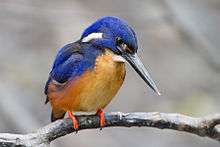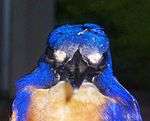Azure kingfisher
| Azure kingfisher | |
|---|---|
 | |
| A. a. ruficollaris | |
| Scientific classification | |
| Kingdom: | Animalia |
| Phylum: | Chordata |
| Class: | Aves |
| Order: | Coraciiformes |
| Family: | Alcedinidae |
| Subfamily: | Alcedininae |
| Genus: | Ceyx |
| Species: | C. azureus |
| Binomial name | |
| Ceyx azureus Latham, 1801 | |
| Subspecies | |
| |
| Synonyms | |
|
Alcedo azurea | |
The azure kingfisher (Ceyx azureus) is a small kingfisher (17–19 centimetres (6.7–7.5 in)), in the river kingfisher subfamily, Alcedininae. It is found in Northern and Eastern Australia and Tasmania, as well as the lowlands of New Guinea and neighbouring islands, and out to North Maluku and Romang.
It is a very colourful bird, with deep blue to azure back, a large white to buff spot on side of neck and throat, rufous-buff with some blue-violet streaks on breast and flanks. The feet are red with only two forward toes. The lores (the region between the eye and the bill) are white and inconspicuous except in front view, where they stand out as two large white eye-like spots which may have a role in warding off potential predators.

The subspecies differ only in minor details. ruficollaris is smaller, brighter, and has more blue on the flanks. diemenensis is rather large, short-billed, and has a distinctly darker crown. lessoni is more contrasting, with little blue on the flanks. affinis has a red billtip, as has the smaller yamdenae, and ochrogaster is very pale below. Still, there is very little intergradation in the areas where subspecies meet. Comparing subspecific variation with climate data, the former's pattern does not follow and in some instances runs contrary to Bergmann's Rule and Gloger's Rule (Schodde & Mason, 1976, Woodall, 2001).
The contact zone between the mainland Australian subspecies is along the east coast of Far North Queensland, between Cairns and Princess Charlotte Bay (Schodde & Mason 1976), that of the New Guinea ones between Simbu Province and the northern Huon Peninsula, as well as south of Cenderawasih Bay (Woodall, 2001).
Habitat includes the banks of vegetated creeks, lakes, swamps, tidal estuaries and mangroves. Often difficult to see until it quickly darts from a perch above water. Feeds on freshwater yabbies and small fish. Nest in a chamber up to 1 metre long in an earthen creek bank. 5–7 white, rounded, glossy eggs. Voice is a high-pitched, shrill, 'pseet-pseet'.
References
- ↑ BirdLife International (2012). "Ceyx azureus". IUCN Red List of Threatened Species. Version 2013.2. International Union for Conservation of Nature. Retrieved 26 November 2013.
- Morcombe, Michael K. (2000): Field Guide to Australian Birds. Steve Parish Publishing, Archerfield, Australia. ISBN 1-876282-10-X
- Slater, Peter; Slater, Pat & Slater, Raoul (1989): The Slater Field Guide to Australian Birds (Revised Edition). Weldon, Sydney, Chicago. ISBN 0-947116-99-0
- Pizzey, Graham (1980): A field guide to the birds of Australia. Collins, Sydney. ISBN 0-00-219201-2
- Schodde, R. & Mason I.J. (1976): Infra-specific variation in Alcedo azurea Latham (Alcedinidae). Emu 76(1): 161–166. doi:10.1071/MU9760161 (HTML abstract)
- Woodall, Peter: (2001): 77. Azure Kingfisher. In: del Hoyo, Josep; Elliott, Andrew & Sargatal, Jordi (editors): Handbook of Birds of the World, Volume 6 (Mousebirds to Hornbills): 237, plate 19. Lynx Edicions, Barcelona. ISBN 84-87334-30-X
External links
 Media related to Alcedo azurea at Wikimedia Commons
Media related to Alcedo azurea at Wikimedia Commons
![]() Data related to Alcedo azurea at Wikispecies
Data related to Alcedo azurea at Wikispecies
